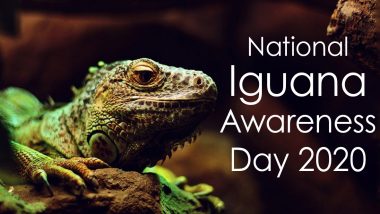National Iguana Awareness Day is observed to raise awareness on the endangered reptiles. The day is to create awareness about the cold-blooded reptiles. National Iguana Awareness Day 2020 falls on September 8. The day is an ideal opportunity to learn about keeping your iguana tame and friendly. It is also to highlight health and personal grooming, and how to house an iguana comfortably. While they are aggressive, it can give you a nasty bite and has a powerfully strong tail, they can also be tamed down. With the proper care and attention, an iguana can be a wonderful and rewarding pet for many years. On National Iguana Awareness Day 2020, we look at some interesting facts on these reptiles. Iguanas Are Falling off Trees AGAIN! Viral Images and Videos Show Frozen Reptiles Losing Their Grip Due to Extreme Cold in Florida.
Commonly kept as house pets, green iguanas are tree-climbing lizards native to the Caribbean and Central and South America. They are identified by their stocky stature, the saggy skin on their throats and the spines that protrude from their heads, necks, backs and tails. Iguanas can live upto 15 to 20 years if taken good care.
- The green iguana is the longest iguanas and grows to between 5 and 7 feet long from nose to tail.
- Iguanas like warm temperatures because they are cold-blooded.
- Most iguanas are herbivores and only eat vegetation such as flower buds, fruits and young leaves.
- The marine iguana gets its meal by scraping algae from rocks in the ocean or by munching on seaweed.
- Pet iguanas and some wild iguanas enjoy worms, crickets and baby mice along with vegetation.
- Iguanas typically spend their days lounging in the sun to keep warm and from time to time they will get up for a snack.
- Only two of the Fiji banded iguana found on are found on two islands as its population has dropped by 50 percent in the past 30 to 45 years.
- The Galápagos pink land iguana is labelled as critically endangered. As of 2012, only one small population existed.
- The female rock iguana lays five to 20 eggs, while the green iguana lays around 65 eggs.
According to the International Union for Conservation of Nature (IUCN), iguanas are among the most endangered animals in the world. In the wild, the number of iguanas is dropping drastically due to loss of habitat and predators. The Galapagos marine iguana is black in colour which helps them absorb heat from the sun after swimming in the ocean. Marine iguanas have flattened tails that let them swim. In Central and South America, people farm and eat iguanas.
(The above story first appeared on LatestLY on Sep 08, 2020 09:10 AM IST. For more news and updates on politics, world, sports, entertainment and lifestyle, log on to our website latestly.com).













 Quickly
Quickly




















